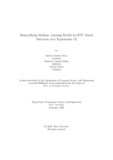| dc.contributor.advisor | Hossain, Muhammad Iqbal | |
| dc.contributor.advisor | Alam, Md. Golam Rabiul | |
| dc.contributor.author | Muna, Rabeya Khatun | |
| dc.contributor.author | Maliha, Homaira Tasnim | |
| dc.contributor.author | Hasan, Mahedi | |
| dc.date.accessioned | 2021-10-26T06:57:50Z | |
| dc.date.available | 2021-10-26T06:57:50Z | |
| dc.date.copyright | 2021 | |
| dc.date.issued | 2021-09 | |
| dc.identifier.other | ID 21341056 | |
| dc.identifier.other | ID 18101455 | |
| dc.identifier.other | ID 17101544 | |
| dc.identifier.uri | http://hdl.handle.net/10361/15553 | |
| dc.description | This thesis is submitted in partial fulfillment of the requirements for the degree of Bachelor of Science in Computer Science and Engineering, 2021. | en_US |
| dc.description | Cataloged from PDF version of thesis. | |
| dc.description | Includes bibliographical references (pages 43-44). | |
| dc.description.abstract | Internet of things (IoT) dramatically is changing our lives with its newly invented
devices and applications which leads to various emerging cybersecurity challenges
or threats. The rapid growth of IoT arouses security and privacy issues that need
more attention to ensure the safety of human personal data, saving from serious
damages. Over the year, several techniques have been conducted to establish IoT
attack detection model so that it can detect attacks e ciently. Unfortunately, it is
di cult to identify a good model that can detect both binary and multi-type attacks
with accurately. The prediction result of models provides very little knowledge to
the users or experts how the model classify attacks for detection which can not be
understood through a simple output. Thus, it is getting necessary to understand
the reasons behind the prediction to make people trust on the model by providing
the insight view of the model.
In the paper, we have introduced Explainable Arti cial Intelligent on our proposed
model for making the model faithful enough and human understandable, by explaining
the strategy of the detection model for predicting the attacks and representing
the features or properties in
uence of respective prediction. For this, we have establish
an IoT attack detection model by using Xg-boost classi er on a dataset, name,
IoT Intrusion Dataset[11], that supports both binary and multi-class classi cation
to classify the attacks for detection. We have also used Explainable AI tools, named,
Shap, Lime, and ELI5 to validate the performance of the model through analyzing
the property of the established model by representing each feature's contribution
and action of the model, for each prediction to give a clear idea how e cient the
model is, for detecting the IoT attacks. | en_US |
| dc.description.statementofresponsibility | Rabeya Khatun Muna | |
| dc.description.statementofresponsibility | Homaira Tasnim Maliha | |
| dc.description.statementofresponsibility | Mahedi Hasan | |
| dc.format.extent | 44 pages | |
| dc.language.iso | en | en_US |
| dc.publisher | Brac University | en_US |
| dc.rights | Brac University theses are protected by copyright. They may be viewed from this source for any purpose, but reproduction or distribution in any format is prohibited without written permission. | |
| dc.subject | Xg-boost | en_US |
| dc.subject | Explainable AI | en_US |
| dc.subject | XAI | en_US |
| dc.subject | Lime | en_US |
| dc.subject | Shap | en_US |
| dc.subject | ELI5 | en_US |
| dc.subject | IoT attack | en_US |
| dc.subject | SMOTE | en_US |
| dc.subject | PCA | en_US |
| dc.subject.lcsh | Machine learning | |
| dc.subject.lcsh | Internet of things | |
| dc.title | Demystifying machine learning models for IOT attack detection with explainable AI | en_US |
| dc.type | Thesis | en_US |
| dc.contributor.department | Department of Computer Science and Engineering, Brac University | |
| dc.description.degree | B. Computer Science | |

